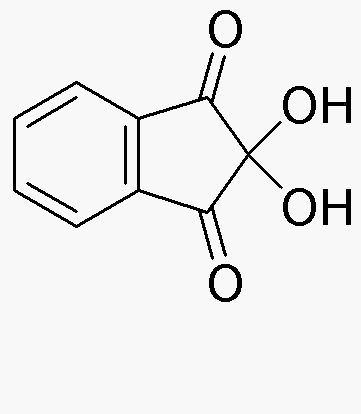Ninhydrin is widely utilized in research focused on:
- Forensic Science: It is a key reagent for detecting amino acids in fingerprints, making it invaluable for crime scene investigations.
- Biochemistry: Used to quantify amino acids and proteins, aiding in nutritional studies and protein research.
- Histology: Employed in tissue staining to visualize proteins, enhancing the study of cellular structures in medical research.
- Food Industry: Assists in analyzing protein content and quality in food products, ensuring compliance with safety standards.
- Educational Laboratories: Commonly used in chemistry education for experiments related to protein analysis, helping students understand biochemical processes.
General Information
Properties
Safety and Regulations
Applications
Ninhydrin is widely utilized in research focused on:
- Forensic Science: It is a key reagent for detecting amino acids in fingerprints, making it invaluable for crime scene investigations.
- Biochemistry: Used to quantify amino acids and proteins, aiding in nutritional studies and protein research.
- Histology: Employed in tissue staining to visualize proteins, enhancing the study of cellular structures in medical research.
- Food Industry: Assists in analyzing protein content and quality in food products, ensuring compliance with safety standards.
- Educational Laboratories: Commonly used in chemistry education for experiments related to protein analysis, helping students understand biochemical processes.
Documents
Safety Data Sheets (SDS)
The SDS provides comprehensive safety information on handling, storage, and disposal of the product.
Product Specification (PS)
The PS provides a comprehensive breakdown of the product’s properties, including chemical composition, physical state, purity, and storage requirements. It also details acceptable quality ranges and the product's intended applications.
Certificates of Analysis (COA)
Search for Certificates of Analysis (COA) by entering the products Lot Number. Lot and Batch Numbers can be found on a product’s label following the words ‘Lot’ or ‘Batch’.
*Catalog Number
*Lot Number
Certificates Of Origin (COO)
This COO confirms the country where the product was manufactured, and also details the materials and components used in it and whether it is derived from natural, synthetic, or other specific sources. This certificate may be required for customs, trade, and regulatory compliance.
*Catalog Number
*Lot Number
Safety Data Sheets (SDS)
The SDS provides comprehensive safety information on handling, storage, and disposal of the product.
DownloadProduct Specification (PS)
The PS provides a comprehensive breakdown of the product’s properties, including chemical composition, physical state, purity, and storage requirements. It also details acceptable quality ranges and the product's intended applications.
DownloadCertificates of Analysis (COA)
Search for Certificates of Analysis (COA) by entering the products Lot Number. Lot and Batch Numbers can be found on a product’s label following the words ‘Lot’ or ‘Batch’.
*Catalog Number
*Lot Number
Certificates Of Origin (COO)
This COO confirms the country where the product was manufactured, and also details the materials and components used in it and whether it is derived from natural, synthetic, or other specific sources. This certificate may be required for customs, trade, and regulatory compliance.


